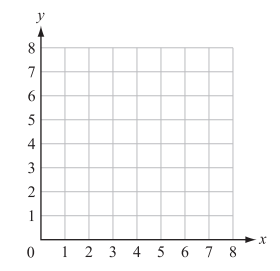Coordinate Geometry
Help Questions
ISEE Lower Level Quantitative Reasoning › Coordinate Geometry
A coordinate plane is shown.

Ralph plotted the following points on the coordinate grid:
Point W (2, 4); Point X (3, 6); Point Y (5, 4); Point Z (6, 6)
A polygon is formed with vertices W, X, Y, and Z. Which type of polygon is formed?
Parallelogram
Trapezoid
Kite
Pentagon
Square
Explanation
Begin by plotting the points and connecting the vertices.

The quadrilateral that is created has two sets of parallel sides. Out of the possible answer choices, this can describe both squares and parallelograms. Because the figure does not contain right angles and the sides are not all the same length, it must be a parallelogram.
Select the graph that displays the polygon created using the following coordinates:




Explanation
When we are given coordinate points, it's important to know the difference between the x-axis and the y-axis, and which order these points are given. The x-axis is the axis that runs left to right and the y-axis is the axis the runs up and down. When coordinate points are written, the x value goes first, followed by the y value 
Knowing this information, we can plot the points and use straight lines to connect them in a counter-clockwise or clockwise direction. The provided coordinate points should create the following graph:

Select the graph that displays the polygon created using the following coordinates:




Explanation
When we are given coordinate points, it's important to know the difference between the x-axis and the y-axis, and which order these points are given. The x-axis is the axis that runs left to right and the y-axis is the axis the runs up and down. When coordinate points are written, the x value goes first, followed by the y value 
Knowing this information, we can plot the points and use straight lines to connect them in a counter-clockwise or clockwise direction. The provided coordinate points should create the following graph:

Square 









Explanation
The area of square 
The solution is:
width 

Square 









Explanation
The area of square 
The solution is:
width 


Square ABCD has coordinate points: 








Explanation
To find the area of square 


Thus, the solution is:

The above triangle has a height of 





Explanation
In order to find the area of this triangle apply the formula:

The triangle shown above has a base of 

Explanation
The perimeter of this triangle can be found using the formula:
Thus, the solution is:
Select the graph that displays the polygon created using the following coordinates:




Explanation
When we are given coordinate points, it's important to know the difference between the x-axis and the y-axis, and which order these points are given. The x-axis is the axis that runs left to right and the y-axis is the axis the runs up and down. When coordinate points are written, the x value goes first, followed by the y value 
Knowing this information, we can plot the points and use straight lines to connect them in a counter-clockwise or clockwise direction. The provided coordinate points should create the following graph:

Select the graph that displays the polygon created using the following coordinates:




Explanation
When we are given coordinate points, it's important to know the difference between the x-axis and the y-axis, and which order these points are given. The x-axis is the axis that runs left to right and the y-axis is the axis the runs up and down. When coordinate points are written, the x value goes first, followed by the y value 
Knowing this information, we can plot the points and use straight lines to connect them in a counter-clockwise or clockwise direction. The provided coordinate points should create the following graph:


























